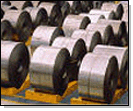
| 
| Latest Business news on mobile: sms BIZ to 7333 |

Home > Business > Business Headline > Budget 2005-06 > Report
Steel: Budget may provide boost
February 24, 2005 06:57 IST
 Being a core sector, steel industry tracks the overall economic growth in the long-term. Also, steel demand, being derived from other sectors like automobiles, consumer durables and infrastructure, its fortune is dependent on the growth of these user industries. India has a per capita consumption of steel of around 30 kgs as against 180 kgs in China and an average of over 400 kgs in the developed countries. This wide gap in relative steel consumption indicates that the potential ahead for India to raise its steel consumption is high. | | Key Positives | | | Growth potential: The per capita steel consumption in India is abysmally low at around 30 kgs as compared to 180 kgs of China and over 400 kgs in developed countries. This wide gap in relative steel consumption indicates that the potential ahead for India to raise its steel consumption is high. | | The China effect: Domestic steel companies have benefited immensely on the back of rise in international steel prices and demand. The prices continue to remain strong and the demand is likely to sustain in the current year on the back of demand from countries like China. | | Domestic impetus: A robust housing sector, with growth potential in the auto and the consumer durables sector is likely to be a big positive for the steel sector. | | Cost advantage: Indian steel producers are one of the lowest cost producers in the world. With exports on the rise leading to better realisations, the bottomline of the companies is likely to be positively impacted. |
| | | Key Negatives | | | The Chine threat: A key threat to the steel sector continues to be from the consumption pattern of China, which is amongst the largest global consumers of steel. With internal capacities on the rise in the country, going forward, it is likely to meet its demand internally. In fact, as per reports, the country's exports of steel exceeded its imports in the closing months of 2004. | | Demand-supply scenario: With global steel capacity on the rise, the impact of which is likely to be felt sooner than later, any falter on the demand front could lead to pressure on steel prices. It must be noted 2004 saw mixed economic growth signals emanating from developed economies, which needs to be kept in mind. | | High input costs: Further, even if steel prices continue to rule firm in the near-term on the back of high input costs, the impact on margins is likely to be muted. | | Waning tariff protection: Over the years, import duties have been consistently brought down and the steel industry has been increasingly exposed to international competition. Just to put things in perspective, the import duties on various steel products have come down from as high as 80% to the current 15%-20%. The reduction in import duties reduces the net tariff protection for steel producers. |
|

This is part of Equitymaster's Budget 2005-06 series. Equitymaster.com is one of India's premier finance portals. The Web site offers a user-friendly portfolio tracker, a weekly buy/sell recommendation service and research reports on India's top companies.
Budget 2005-06: Complete Coverage

| 
| 
|